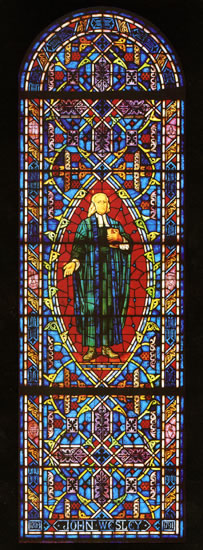
Born in Epworth, England, John Wesley was educated at Charterhouse School in London and Oxford University. In 1735, he set sail for America where, with his brother Charles, he spent two years as a missionary. The voyage brought him in contact with the Moravians who exercised a great deal of influence on his life. On May 24, 1738, the experience of the “warm heart” came to him in a meeting on Aldersgate Street in London. For the first time, the forgiveness of sins became real to him. Throughout his ministry he emphasized the doctrine of the assurance of forgiveness as a witness of the spirit of God.
The first Methodist Society was organized in 1739. Meeting places were built in Bristol (The New Room) and in London (The Foundry), and special meetings were held for participation in the Lord’s Supper. The first annual conference was help in 1744. After a long period of deliberation, John Wesley ordained the first Methodist preachers for work in America. Thomas Coke in turn ordained Francis Asbury as “superintendent.” Later, the term “bishop” was used.
Religion was a very practical matter with the founder of Methodism. For that reason Wesley formulated the General Rules in 1743 as a guide for those who joined one of the societies. When the legal problem of the standing of the societies was solved by the Deed of Declaration in 1784, the following documents were cited as resource materials for right beliefs: the Canon of Scripture;the Twenty-five Articles of Religion (an abridgment and adaptation of the Thirty-nine Articles of the Church of England); the first 53 Sermons of Wesley; and Wesley’s Notes on the New Testament. The doctrines of the Methodist movement are identical with those generally accepted by historical Christianity. The unique emphasis of the movement has been on the personal experience in Christian life.
The left side border symbols of the John Wesley window, numbered from top to bottom, are: 1. an Irish cross, highly decorated and often used in Irish cemeteries, representing Wesley’s significant ministry in Ireland, Wales, and England; 2. a staff with a purse, a traditional symbol of the pilgrim, relating to the itinerant ministry of John Wesley; and 3. the shield of St. Paul symbolizing the spiritual warfare that Paul waged in his lifetime and representing Wesley’s struggle for inward spiritual peace.
The right side border symbols of the John Wesley window, numbered from top to bottom, are: 1 a triquetra representing the Holy Trinity; 2. the symbol of Zion, a reminder of the goal of “a New Heaven and a New Earth” toward which all Christian activity is aimed (Revelation 21:1); and 3. a heart with a flame symbolizing charity and indicating love to God and man. The symbol is appropriate for Wesley’s life: the denomination he founded often is called the religion of the “warm heart.”














